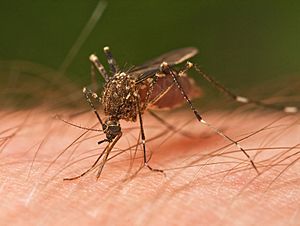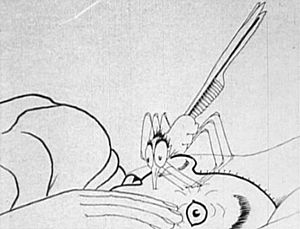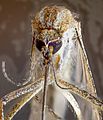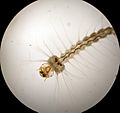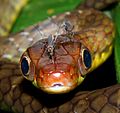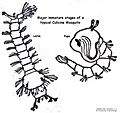Mosquito facts for kids
Quick facts for kids Mosquito |
|
|---|---|
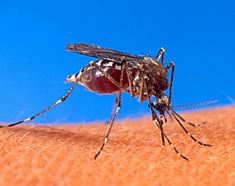 |
|
| Aedes aegypti: the vector of dengue fever and yellow fever |
|
| Scientific classification | |
| Kingdom: | |
| Phylum: | |
| Class: | |
| Order: | |
| Suborder: | |
| Family: |
Culicidae
|
| Subfamilies | |
|
Anophelinae |
|
| Diversity | |
| 43 genera | |
A mosquito is a type of fly. It is the common name of a family of flies in the order Diptera. The word "mosquito" (formed by mosca and diminutive -ito) is Spanish for "little fly".
The females are ectoparasites: they land on warm-blooded animals, pierce a capillary, and inject saliva to stop the blood coagulating. Then they suck up and eat the blood. Deadly microscopic parasites often live in the saliva.
The males are nectar-feeders, and so are the females. However, in preparation for egg-laying the females turn to blood for its protein.
Contents
Evolution
The oldest known mosquito with a basically modern anatomy was found in 79-million-year-old Canadian amber from the Upper Cretaceous. An older sister species with more primitive features was found in amber that is 90 to 100 million years old.
Genetic analyses indicate that the Culicinae and Anophelinae clades may have diverged about 150 million years ago. The Old and New World Anopheles species are believed to have subsequently diverged about 95 million years ago.
Feeding & reproduction
Usually both male and female mosquitoes feed on nectar and plant juices. In many species the mouthparts of the females are adapted for piercing the skin of animal hosts and sucking their blood as ectoparasites. In many species, the female needs to get proteins from a blood meal before she can produce eggs. In many other species, she can produce more eggs after a blood meal.
They lay their eggs in pools of water. The larvae move around near the surface of the water, breathing through air tubes that stick out of the water. They get their food from the water, usually eating algae and other tiny creatures. They like to wiggle around near the surface, which is why some people call them wigglers. The larvae usually enter the pupa stage within a few days or weeks of hatching, depending on the water temperature and the species.
The pupae are called tumblers because they tumble in the water if the water is touched. Tumblers do not eat, but they move around in the water a lot, and like larvae, they breathe from tubes that stick out of the water. The pupa stage is short (only for a few days), and then the mosquito becomes an adult.
There are many species of mosquito. This comes about because, of those which suck blood, each species is adapted to a different host or group of hosts. There are two subfamilies, 43 genera and over 3,500 species of the Culicidae.
Vectors for disease
Mosquitoes are a vector (carrier) which carries disease-causing viruses and parasites from person to person.
The principal mosquito borne diseases are the viral diseases yellow fever, dengue fever and malaria carried by the genera Anopheles and Culex. Mosquitoes transmit disease to more than 700 million people annually in Africa, South America, Central America, Mexico and much of Asia with millions of resulting deaths.
Mosquito control
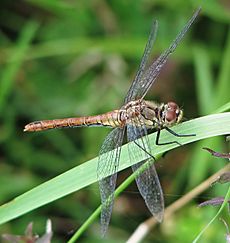
Methods used to prevent the spread of disease, or to protect individuals in areas where disease is endemic include:
- Vector control aimed at mosquito eradication. Habitat change: removing stagnant water and other breeding areas; pesticides; natural predators; and trapping.
- Disease prevention, using prophylactic drugs and vaccines; and preventing mosquito bites, with insecticides, nets and repellents.
Water
Standing water, as in a pond or lake, is the main breeding ground. It may or may not be practical to eliminate this water. The water in bird baths can be changed once a week, but one can hardly do that with larger bodies of water. The method used to be: spray water with DDT, but that does a lot of damage, and in any event the mosquito is now highly resistant to the chemical.
Organic repellents
With increasing reports of the harmful effects DEET has on humans, there has been a move to repellents which are organic. These are of the kind that have had traditional household purposes before their being used as mosquito repellents.
Natural predators
The dragonfly nymph eats mosquitoes at all stages of development and is quite effective in controlling populations. Some copepods are predators on first instar larvae, killing up to 40 Aedes larvae per day. A number of fish eat mosquito larvae, including goldfish, catfish, piranhas, and minnows.
Bites
Mechanism
Visible, irritating bites are due to an immune response from the binding of IgG and IgE antibodies to antigens in the mosquito's saliva. Some of the sensitizing antigens are common to all mosquito species, whereas others are specific to certain species. There are both immediate hypersensitivity reactions (types I and III) and delayed hypersensitivity reactions (type IV) to mosquito bites. Both reactions result in itching, redness and swelling. Immediate reactions develop within a few minutes of the bite and last for a few hours. Delayed reactions take around a day to develop, and last for up to a week.
Treatment
Several anti-itch medications are commercially available, including those taken orally, such as diphenhydramine, or topically applied antihistamines and, for more severe cases, corticosteroids, such as hydrocortisone and triamcinolone. A common topical remedy in camping gear is aqueous ammonia.
Both topical heat and cool may be useful to treat mosquito bites.
In human culture
Greek mythology
Ancient Greek beast fables including "The Elephant and the Mosquito" and "The Bull and the Mosquito", with the general moral that the large beast does not even notice the small one, derive ultimately from Mesopotamia.
Origin myths
The peoples of Siberia have origin myths surrounding the mosquito. One Ostiak myth tells of a man-eating giant, Punegusse, who is killed by a hero but will not stay dead. The hero eventually burns the giant, but the ashes of the fire become mosquitoes that continue to plague mankind.
Other myths from the Yakuts, Goldes (Nanai people), and Samoyed have the insect arising from the ashes or fragments of some giant creature or demon. Similar tales found in Native North American myth, with the mosquito arising from the ashes of a man-eater, suggest a common origin. The Tatars of the Altai had a similar myth, thought to be of Native North American origin, involving the fragments of the dead giant, Andalma-Muus, becoming mosquitoes and other insects.
Modern era
Winsor McCay's 1912 film How a Mosquito Operates was one of the earliest works of animation, which has been described as far ahead of its time in technical quality. It depicts a giant mosquito tormenting a sleeping man.
The de Havilland Mosquito was a high-speed aircraft manufactured between 1940 and 1950, and used in many roles.
Interesting facts about mosquitoes
- Over 3,500 species of mosquitoes have thus far been described in the scientific literature.
- By transmitting diseases, mosquitoes cause the deaths of more people than any other animal: over 700,000 each year.
- Mosquitoes are cosmopolitan (world-wide): they are in every land region except Antarctica and a few islands with polar or subpolar climates. Iceland is such an island, being essentially free of mosquitoes.
- Several flowers are pollinated by mosquitoes, including some members of the Asteraceae, Rosaceae and Orchidaceae.
- In warm and humid tropical regions, some mosquito species are active for the entire year, but in temperate and cold regions they hibernate.
- Mosquito species have spread worldwide with the help of humans. They have also been carried by personal vehicles, delivery trucks, trains, ships, and aircraft.
- No study has shown that Electronic insect repellent devices that produce ultrasounds prevent a human from being bitten by a mosquito.
Images for kids
-
Electron micrograph of a mosquito egg
-
Adult yellow fever mosquito Aedes aegypti, typical of subfamily Culicinae. Note bushy antennae and longer palps of male on left vs. females at right.
-
Aedes aegypti, a common vector of dengue fever and yellow fever
-
Anopheles albimanus mosquito feeding on a human arm – this mosquito is the sole vector of malaria, and mosquito control is a very effective way of reducing the incidence of malaria.
-
Anopheles larva from southern Germany, about 8 mm long
See also
 In Spanish: Culicidae para niños
In Spanish: Culicidae para niños



